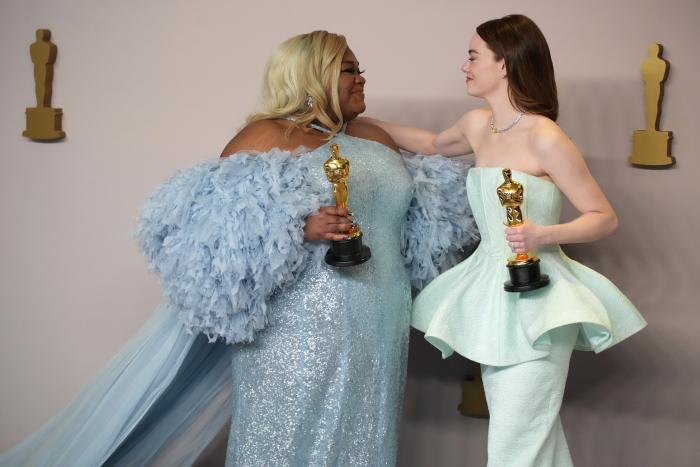

'Conjuring 2' Is the 'Fast & Furious' of Horror Movies (And That's Not a Bad Thing)
By Dustin Rowles | Film | June 10, 2016 |
By Dustin Rowles | Film | June 10, 2016 |
Conjuring 2, the sequel to 2013’s hugely surprising $315 million worldwide box-office hit, returns James Wan as director, after coming off the intentional blockbuster Furious 7. In Conjuring 2, Wan has taken some lessons from his time with the Fast and Furious franchise and applied them to a horror movie, and the result is a wildly uneven film, but it’s an unevenness that benefits Conjuring 2.
Wan, especially with his Insidious movies, is something of the king of the jump scare, and in the back half of Conjuring 2, he delivers those jump scares at a Fast and Furious pace. The front half, however, is more in line with the original Conjuring: Atmospheric, slow-moving, and terrifying, punctuated with the occasional jump scare.
I’m not a huge fan of the atmospheric horror film. There’s a very thin line between what is effective and what is boring. In the rare instance when it is effective, these horror films end up feeling like an endurance test. How much tension and dread can you handle?
The first hour of Conjuring 2 is effective without being boring, setting up the London-set Amityville, the Enfield council house owned by the Hodgson family back in 1977. What’s most effective here is that it’s the kids who are being spooked by the spirit of a former occupant, and as a parent watching it, there’s a certain feeling of helplessness in seeeing kids have to deal with demonic spirits on their own. This particular spirit possesses 11-year-old Janet (Madison Wolfe) and it toys with her and her sister while their mom is asleep or away.
Smartly, however, there’s no real attempt to hide the poltergeist activity from the outside world: Neighbors and the police come over, and they witness the same activity. The media, likewise, gets in on the action. However, the potential fear that it’s an elaborate (and almost impossible to pull off) hoax prompts the church to recruit Ed and Lorraine Warren (Patrick Wilson and Vera Farmigina, respectively) to fly to London to verify that it’s real before embarking upon whatever it is the church does to rid houses of poltergeists.
It’s when the Warrens arrive that the Conjuring 2 transforms from a spooky, atmospheric horror to something more akin to a horror-action film. The scares and the frightening imagery are louder and more frequent, which interestingly makes the movie less scary but more fun. The back half is also incredibly dumb in a popcorn-blockbuster kind of way. However, there are few lulls to allow us to catch our breaths or think about the movie long enough to dismiss the stupidity of it.
In other words, it’s a spooky-scary movie that evolves into a fun-scary movie. It never takes itself too seriously, but the creepy imagery and the fear of death is enough to keep us reasonably terrified.
Ultimately, it works because Wan is as interested in entertaining us as he is in scaring us, and so often horror films fail in the first respect (the Paranormal Activity movies, for instance, are often effectively scary, but they’re also exceedingly boring). If you liked the first Conjuring and the Insidious films, there’s no reason why you wouldn’t like Conjuring 2.
Interestingly, so-called experts were split on whether there was real-life poltergeist activity in the Enfield house back in 1977 (Maurice Grosse and Anita Gregory are real people depicted in the film, representing the two sides of the debate). The Warrens did visit the house in 1978, and they were convinced that it was haunted, though Janet Hodgson would later admit that she fakes some — but not all — of the phenomena (and that is illustrated in the film).
Here’s the real recording of the poltergeist depicted in the film (and this recording is played over the credits). Some believe it was the work of a very skilled ventriloquist, while other believed that the disembodied voice defied “the laws of mechanics.” The Warrens, however, lent some credibility to claims that the poltergeist — and demonic activity — were real.
I’m sure it was all faked, because poltergeist aren’t real.
But then again, maybe they are.
← Review: 'Careful What You Wish For' Or The Unwanted Child Of Porn and Lifetime Movies | Ranking Each 'Game of Thrones' Plotline From Best to Theon →

What’s Old Is New Again: Old Hollywood Glamour Glitters at the 2024 Oscars
Al Pacino Presents Best Picture Oscar, Confuses Everyone
The Dangerous Lie Of 'TradWives'
A Legendary Horror Franchise Is Headed To Television
'The Mandalorian' Season 4 Is Probably Not Happening
Halle Bailey On Why She Chose To Keep Her Pregnancy Private
More Like This
Kyle Mooney's Horror-Comedy 'Y2K' Goes Too Hard on Kyle Mooney's Sense of Humor
'Imaginary' Almost Sucks
Box Office Report: Kung Fu Sandworms
The 2024 Oscars Were Great Right Up Until the End
Kristen Stewart's 'Love Lies Bleeding' Is Gonna Kick Your Ass And Make You Beg For More
Reviews